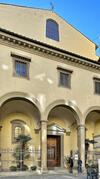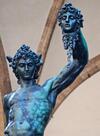The NY Times weighs in on the "Cow Parade"
It took them a little while to get around to it but the NY Times has an article about Florence's Cow Parade:
Renaissance-era public art in this Medici stronghold gave the world Michelangelo's David and monumental sculptures by Donatello. These days, Florentines are sharing their cobbled streets with a colorful fiberglass herd that's part of CowParade, which is billed as the world's largest public-art event and has already stampeded through some two dozen cities around the globe.It's one thing to have life-size, mass-produced cow forms crowding the sidewalks in Houston, New York, or Manchester, England, but quite another in Florence, where there are churches by Brunelleschi as a backdrop, not to mention fiercely protective - and restrictive - art authorities.
"We were worried when we spoke to the art officials because this exhibit is extravagant," said Giovanni Rimbotti, president of AgencyOne, the Italian entity set up to organize the event. "But they took it in the right way, with a smile."
In other cities artists have had free rein in creating the cows, but in Florence the projects were carefully vetted by a committee, which selected 58 artists from more than 1,000 proposals. "This is Florence; there had to be some control," said Patrizia Asproni, the president of Confcultura, an organization that promotes Italy's cultural heritage. The decision to keep the herd small (compared with the 520 cows in New York and 156 in Manchester) also took Florence's size into consideration.It was a Swiss sculptor, Pascal Knapp, who turned the 130-pound fiberglass bovine into contemporary art. Since first appearing at a public art show in Zurich in 1998, Mr. Knapp's three models (standing, grazing and seated) have served as models for more than 5,000 artists in more than 20 cities.
CowParade organizers don't claim to aspire to high art. The exhibitions are meant to be amusing rather than museological, relying on the crowd-pleasing appeal of their subject, with a good dose of whimsy thrown in. "Cows are familiar, placid and comical, and that should be the leitmotif of the show," said Simone Siliani, who heads Florence's culture department.
Here, that's translated into pieces like Massimo Rossetti's "Mucca Bruca Blister," packaged with a user's guide in Italian, English and Japanese: "check if every single piece of the cow are in the right place (should be as in the picture); ask for permission to milk"; and Luigi Fragoli and Fiona Corsini's "Allumeuse," a cow-turned-lamp that lights up at night. For the most part, Italians have been spared English-speakers' compulsion to play with puns in the titles, which birthed works like Picowsso, Moondrian and MooMa when CowParade hit Moo York in 2000.
Most of the artists aren't well known, but that, organizers say, is part of the specialness of the event. "CowParade isn't successful because the cows are made by famous artists but because the cows are 'simpatiche,' " Mr. Rimbotti said.
Even so, some organizers weren't very optimistic about how Florentines would respond to the project. "It's a sleepy city, squashed by the weight of the Renaissance, from which it has a hard time emerging," Ms. Asproni said. "The city stopped in one era and has a hard time accepting anything new, like contemporary art."
Actually, tourists and Florentines seemed mostly amused by the bovines, which are already vying with the city's monuments for photographic immortalization. "We can buy postcards of the monuments, but we're not going to get any images of these," said Angela Rossi, a translator from a town on the Adriatic, explaining why she chose to photograph Julia Pircher's bright yellow cow, "Miss Cheese Italy," instead of the famed Romanesque baptistery a few yards away. "It's not so ugly," she said of the cow.
CowParades have been successful enough around the world to generate their own merchandising bonanza (everything from calendars to snow globes) and credit cards. They are also touted as a big tourist draw for local businesses.
That may not seem like a big priority for a city that drew an estimated nine million visitors last year, but Silvano Gori, the municipal commissioner for tourism, said he hoped the event would fill Florence during the slow winter season and broaden the city's appeal. "This example may seem profane, but Florence needs a stimulus to attract a different public," Mr. Gori said.
Florence may benefit from the cows in another way. The exhibition coincides with the probable return to butcher shops of the Fiorentina, a Tuscan-style steak that disappeared from tables four years ago during the mad cow crisis, when beef that included part of the spinal cord was banned. Last month, European Union veterinary experts recommended lifting the ban, and Italian officials are hopeful that the Fiorentina will be back by Christmas.
Florentine businesses have been slow to respond to the potential 30 percent retailing boost of the cows, said Alberto Ridi, a partner in AgencyOne. Of the 58 cows, only 26 were adopted, for prices ranging from about $9,600 to $12,000, a low percentage compared with that in other cities, he said.
Mr. Rimbotti said it was "really sad" that of these 26 only 8 were adopted by Tuscan companies. "It tells you a lot about the city," he said.
Mr. Gori fine-tuned the observation. "This is a city that isn't accustomed to participating," he said. "But if we lose this occasion it will be difficult for other organizers to propose something new for Florence."
At the end of the three-month run, some of the cows will be auctioned off and 70 percent of the proceeds will go to a local charity, the Meyer Children's Hospital, which has pledged the money to its art program. So far cow auctions around the world have netted charities around $24 million, Mr. Rimbotti said.
Flora Vannetti, a Florentine graphic designer who created Moo Jeans, a bright green cow in blue jeans, said she had received good feedback about her piece, adding that only the auction would tell whether people actually liked it.
But she isn't brooding too much about Florence's Renaissance greats. "They were real artists," she said. "You can't compare this with Brunelleschi. I'm just a designer."
Copyright 2005 The New York Times Company
Comments:
Last update:
What's New?
-

March in Florence : Marzo a Firenze
Mar 1, 2025
-

Small Antiques Market, Fiesole
Feb 4, 2025
-

Santa Felicita
Feb 1, 2025
-

February in Florence : Febbraio a Firenze
Feb 1, 2025
-

Cellini's Perseus with the Head of Medusa
Jan 31, 2025
Top experiences in and around Florence:
Some links to external websites may be affiliate links (hotel bookings, guide books, activities, etc.). Using these services helps to support our efforts here with no additional costs to the user (you!).